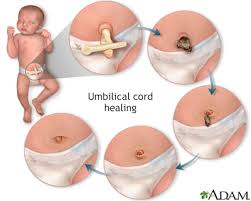A nurse is teaching a newborn's parent how to care for the umbilical cord stump. Which of the following instructions should the nurse include?
Apply petroleum jelly to the cord stump.
Give a sponge bath until the cord stump falls off.
Cover the cord with the diaper.
Wash the cord daily with mild soap and water.
The Correct Answer is B
Choice A reason:
Applying petroleum jelly to the umbilical cord stump is not recommended. The goal is to keep the stump dry to encourage the healing process. Petroleum jelly is a moisture barrier and could potentially keep the area too moist, which may delay the drying and falling off of the stump.
Choice B reason:
Giving sponge baths until the cord stump falls off is the correct practice. It is important to keep the stump dry, so sponge baths are preferred over tub baths during this time. This helps prevent the stump from staying wet, which can lead to infection or delayed healing.
Choice C reason:
It is not advised to cover the cord with the diaper. Instead, the diaper should be folded down away from the stump or use diapers with a special cut-out to keep the stump exposed to air. This helps the stump to dry and fall off more quickly.
Choice D reason:
Washing the cord daily with mild soap and water is not necessary and could be counterproductive. The stump should be kept dry, and if it gets dirty, it can be cleaned gently with a soft, damp cloth and then dried thoroughly. Regular bathing can introduce moisture, which may increase the risk of infection.

Nursing Test Bank
Naxlex Comprehensive Predictor Exams
Related Questions
Correct Answer is D
Explanation
Choice A reason: The rubella vaccine is a live attenuated virus vaccine, which is generally not recommended during pregnancy due to the theoretical risk to the fetus. However, it is safe to receive the rubella vaccine while breastfeeding; it does not pose a risk to the nursing infant.
Choice B reason: The varicella vaccine, which is also a live virus vaccine, should not be administered during pregnancy because of the potential risk to the fetus. Women should be vaccinated before pregnancy or in the postpartum period.
Choice C reason: The Tdap vaccine, which protects against tetanus, diphtheria, and pertussis (whooping cough), is recommended for all pregnant women during each pregnancy, regardless of their previous history of receiving the vaccine. The optimal timing for Tdap administration is between 27 and 36 weeks of gestation to maximize the transfer of antibodies to the baby.
Choice D reason: Pregnant women are encouraged to receive the inactivated influenza vaccine at any point during their pregnancy. The flu shot is safe during pregnancy and helps protect both the mother and the baby from the flu and its complications.
Correct Answer is ["0504"]
Explanation
To calculate the estimated date of birth (EDB), also known as the due date, we use Naegele's Rule, which involves adding one year, subtracting three months, and adding seven days to the first day of the last menstrual period (LMP). Using this rule, if the LMP was on July 27, the EDB would be:
- Add one year: July 27, 2024
- Subtract three months: April 27, 2024
- Add seven days: May 4, 2024
Therefore, the EDB in MMDD format is 0504.
Reason:
Naegele's Rule is a standard way of calculating the due date for a pregnancy. The rule estimates the expected date of delivery (EDD) by adding one year, subtracting three months, and adding seven days to the date of a woman's last menstrual period (LMP). This calculation assumes a regular menstrual cycle of 28 days and ovulation occurring on the 14th day of the cycle. The EDB is typically set at 40 weeks from the LMP, which is approximately 280 days. While this method provides an estimate, only about 4% of births occur on the exact due date, and most births occur within a range of two weeks before or after the estimated due date.
It's important to note that the EDB is an estimate and can be influenced by factors such as the length of menstrual cycles, the exact day of ovulation, and the date of conception. Ultrasounds and other prenatal tests can provide additional information to refine the due date estimate as the pregnancy progresses.
Whether you are a student looking to ace your exams or a practicing nurse seeking to enhance your expertise , our nursing education contents will empower you with the confidence and competence to make a difference in the lives of patients and become a respected leader in the healthcare field.
Visit Naxlex, invest in your future and unlock endless possibilities with our unparalleled nursing education contents today
Report Wrong Answer on the Current Question
Do you disagree with the answer? If yes, what is your expected answer? Explain.
Kindly be descriptive with the issue you are facing.
